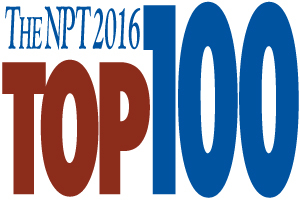The nation’s largest nonprofits continued to see revenue steadily rise during 2015 through a combination of increased public support, program and other revenue, that made up for declines in government funding and investment income.
Public support was approximately $41.378 billion, up more than 8 percent.
The organizations found in The NPT 100 – the 28th annual study of the nation’s largest nonprofits by The NonProfit Times – derived 80 cents of every $1 in revenue either through public support or program service revenue. About 1 in 8 dollars came from government support and about half as much through investment income and other revenue.
Santa Barbara, Calif.-based Direct Relief was typical of an NPT 100 organization on a number of fronts, from seeing increased support in response to a disaster to planning a capital campaign around a new headquarters.
Overall, revenue has been trending on the positive side yet about one-quarter of the organizations experienced a decrease, said Daniel Romano, national partner-in-charge, not-for-profit tax services, at Grant Thornton LLP. The Manhattan-based firm helps to compile and analyze data from hundreds of charities for The NPT 100. “Almost all of those that had declines were affected by decreases in net investment income. It’s a trend and it’s continuing this year,” he said.
Total revenue for the largest 100 organizations was estimated at $74.888 billion, or about 2.6 percent more than the same 100 organizations reported the previous year. The total is slightly less than the $75.449 billion in revenue that last year’s top 100 organizations tallied thanks in part to a couple of large organizations not making the cut this year.
While public support was up, not all categories were winners. Government support declined by more than 10 percent, reported at almost $9.1 billion for the 100 organizations. Some organizations are unable to break out government grants and contracts or fee-for-service revenue and report it all as government support for the NPT 100.
Investment income was about $3.034 billion, or 24 percent less than last year. Program service revenue was up marginally, 1.5 percent, to $18.278 billion. Also helping to offset declines in investment income was other revenue, which was up 15 percent, from $2.54 billion to $2.92 billion. “It shows organizations are trying to do other things, that might be related to programs, maybe conferences, things that they can make money on and draw additional revenue,” Romano said.
The value of investment portfolios increased against investment income that did so poorly last year suggests that financial managers aren’t panicking and selling off investments, Romano said. As he tells clients: “It’s only a loss when you sell it.” Unrealized losses might sting but they don’t count yet, he said.
Total assets were up an average of at least 5 percent, mostly in restricted accounts. People are donating to organizations but earmarking them for certain uses, whether for endowments or other restricted uses, Romano said. “The average increase is there but they may not be able to use it on everyday matters,” he said.
Expenses were up about 5 percent, slightly exceeding — but generally on par — with increases in revenue. The increases were evenly distributed among the three major categories of program, fundraising and management. A major driver of expenses is probably salaries, Romano said.
There’s been a much more concerted effort on strategic initiatives by large organizations in recent years, according to Romano. The landscape will be really different than anything seen now in 10 years. “Organizations are trying to stay ahead of the curve with strategic focus on those types of things,” he said. In the past year, large institutions including the American Red Cross and Metropolitan Museum of Art have restructured to address operating deficits. Other national organizations in recent years have moved to consolidate affiliates.
“We’ve seen that with a number of organizations,” Romano said. Overall, it’s done with the intent to reduce expenses and streamline the process, he said, with the goal of pulling in chapters to reduce costs and eliminate duplicative administrative costs.
American Cancer Society (No. 20) in 2013 moved to transform into one entity, instead of a dozen regional organizations and other affiliates. Alzheimer’s Association (No. 56) and its affiliates earlier this year got the ball rolling on a transformation of the charity from disparate affiliates to one organization. Some affiliates chose to go out on their own rather than consolidate into the national organization.
The top organization by revenue again this year is The Y, with $7.283 billion, mostly made up of program service ($5.175 billion) and public support (1.201 billion).
The No. 100 organization this year was Boston, Mass.-based WGBH Educational Foundation with $190.5 million in overall revenue, down from $195.4 million. Last year’s No. 100 organization was Whitney Museum of American Art, reporting $178.6 million. The New York City museum fell from the list, with $100 million in revenue, after a capital campaign to build and open a new museum concluded.
The last five organizations cut from the study were Medical Teams International, $188.4 million; Children International, $188 million; Matthew 25: Ministries, $187.3 million; and two longtime NPT 100 charities, March of Dimes, $186.7 million, and American Diabetes Association, $182.2 million.
In perhaps another sign that nonprofits don’t survive on donations alone, two large, longtime NPT 100 organizations didn’t make the 10-percent threshold to qualify for the list this year. Organizations must derive at least 10 percent of total revenue from public support. For some, the 10-percent threshold is a balancing act. Easterseals has approached the 10-percent mark in re cent years and this year dropped below it, to 6 percent.
Total revenue for the Chicago, Ill.-headquartered charity was up a healthy 4 percent, almost $86 million from $1.99 billion to $2.076 billion. Much of the overall increase was the result of a 14-percent rise in program service revenue, up $132 million from $925 million to $1.058 billion. Public support was up, but only slightly, about 2 percent or $2.5 million, from $128.4 million to $130.9 million.
Easterseals ranked No. 7 on The NPT 100 last year and likely would have been around the same slot had it met the 10-percent threshold.
The Institute of International Education (IIE) saw a huge jump in revenue, from $586.6 million to $843.3 million. The New York City-based organization ranked No. 33 last year and probably would have been in the top 25. However, the boost in revenue was largely the result of a massive increase in government funds, some $510 million from Brazil for the Brazil Scientific Mobility Program. It also received $158 million from the U.S. State Department for the Fulbright Student and Fulbright Scholar Program.
Legal Aid Society in recent years has fallen from the ranks of the 10-percent. In some years Consumers Union, which publishes Consumer Reports, experienced an increase in public support to cross the 10-percent line, and came about as close as one can this year, at 9.94 percent.
Among other longtime legacy organizations that dropped off the 100 this year are March of Dimes and American Diabetes Association.
Organizations focused on disaster relief saw boosts in revenue as donors reached out to help Nepal after an earthquake struck that country in April 2015. Among the largest jumps in the previous year were experienced by:
- Direct Relief (No. 23), almost $450 million to $888 million;
- AmeriCares (No. 31), $560 million to almost $742 million;
- International Rescue Committee (No. 34), $562 million to $689 million; and,
- MAP International (No. 37), $320 million to $547 million.
Direct Relief hit on a number of themes found among nonprofits within this year’s NPT 100 — increased revenue in response to the Nepal earthquake and Ebola outbreak in West Africa, along with a capital campaign and construction of a new facility.
The earthquake and Ebola outbreak led to the largest-scale efforts in the 67-year history of Direct Relief. The Santa Barbara, Calif.-based charity also embarked on its first-ever capital campaign and in September broke ground on a new facility.
Primarily an in-kind contribution charity, Direct Relief received $610 million in support in the form of humanitarian medical material aid, delivering more than 1,800 tons of medications. Direct Relief was the largest provider of medical material aid against Ebola to Sierra Leone, Liberia and three times to Nepal. Financial assistance to several partner organizations in the form of direct cash grants and awards totaled $2.6 million for emergency related recovery and rebuilding efforts internationally, and in the U.S. community health centers and clinics doing innovative preventative, care, and treatment programs for vulnerable persons in their communities.
About one-third of the increased financial support last year was designated for the Ebola crisis or Nepal earthquake, and reflected increases from all sources, according to Direct Relief President and CEO Tom Tighe.
The real lift came from a significant increase in contributed products, mainly pharmaceutical commodities, medications and vaccines. “Emergencies really drive up contributed cash and product,” Tighe said. Direct Relief budgets about $15 million to $17 million at the start of a typical fiscal year but in recent years it has ranged from $13 million to $20 million. “Each one is a little above what we thought at the beginning of the year,” he said of the past four budget years. The organization has grown from $12 million to about $17 million, irrespective of whether a disaster occurs.
Cash support last year totaled about $32 million, with about $13 million in gifts designated for disasters and other restricted events, and about $4.5 million raised toward a capital campaign.
“People aren’t giving to Direct Relief as much as through Direct Relief to help people in Nepal,” Tighe said. “Interesting ethical issues arise then folks try to strike when fundraising is hot,” he said, estimating that only about 5 to 7 percent of contributions might become recurring.
“Over the past couple of years, we’ve become national, received financial support from all over the country, by virtue of more activity that’s better known. It’s driven financial support more than any particular fundraising technique,” Tighe said. “Emergency inspired fundraising isn’t really the result of fundraising activities but a product of being visible, being around, and having a good reputation,” he said. Direct Relief doesn’t have a direct mail program.
“The key is to trying to figure out how to respectfully keep them interested in work they supported in one instance without bothering them,” Tighe said. “A lot of times people will be inspired. It’s an emotional gift often; we kind of get that. Sometimes they love us, other times, they really want to help people in Nepal or (fight) Ebola,” he said.
The capital campaign for a new facility has been a multi-year effort and is in response to a 2013 change in federal law regulating how to handle contributions of prescription drugs, Tighe said. “If you’re going to handle prescription drugs and take title to gifts, you have to be authorized to possess them,” he said. Among new features of the Drug Supply Chain Security Act, accreditation goes not only to organizations but the facilities they operate. Standards for what an accredited facility requires are up, including such things as temperature control, security, and redundant power supplies.
Direct Relief’s existing facility would require a significant retrofit to meet the new regulations, but it’s also too small, so the first-ever capital campaign was launched early last year, with a goal of $40 million. Direct Relief secured $25 million in contributions and pledges during the silent phase of the campaign before going public late this summer.
Much of the campaign will go toward acquiring land, construction and outfitting the building, with $5 million for building endowment and to pay for increased operating expenses, Tighe said. “It’s not complicated construction but it’s a big footprint,” he said since it’s a warehouse type building, rising 40 feet high and 155,000 square feet, including 25,000 square feet of office space; it’s essentially 3 acres under one roof. Direct Relief owns and occupies a facility of 38,000 square feet, with another 50,000 square feet elsewhere.
The charity broke ground in September at an 8-acre parcel near the city-owned airport, with an aggressive timeline for construction as re-accreditation is required by January 2018, Tighe said. It’s the biggest development in Santa Barbara in 20 years, he added.
Museums also saw rising revenues as a variety of large institutions launched, continued or concluded ambitious capital campaigns as well as construction. The Whitney Museum of American Art ranked No. 100 last year with $178 million in total revenue. It opened a new building in Manhattan the previous year and with its campaign completed saw revenue return to a more typical level of almost $101 million.
Other museums and arts institutions launched new campaigns, including the American Museum of Natural History (AMNH) (No. 66); Museum of Fine Arts, Houston (MFAH) (No. 85), and Lincoln Center for Performing Arts (No. 96).
AMNH saw a rise of more than $100 million in revenue, from $180 million to $284 million — its largest total since at least 2008. Despite declines in investment income of about $15 million, the museum saw contributions increase dramatically, from $78 million to $160 million, the result of a number of major gifts of $20 million and $25 million, associated with expansion plans. MFAH has been preparing for a major expansion, and despite a dip to $163 million last year, the museum returned to The NPT 100 with $215 million in reported revenue. MFAH last made the list in 2014 during the quiet phase of its campaign.
Also new to this year’s list is Harlem Children’s Zone (No. 97), which hadn’t made the list in at least a decade. The Manhattan-based nonprofit more than doubled revenue, going from almost $83 million to nearly $197 million due to some major gifts associated with a capital campaign that’s still in the quiet phase.
The U.S. Olympic Committee fell off the list as it usually does in non-Olympic years, going from $270 million to $141 million, but should return next year with broadcast revenue from the Rio Olympics this past summer.
Many of the fastest-growing organizations year-over-year also were the beneficiaries of noncash contributions, particularly donated pharmaceuticals. The Carter Center (No. 47) jumped from $197 million to $407.5 million, going from No. 91 last year.
One of the main factors contributing to the increase was in-kind gifts of Mectizan tablets, a medication used to treat river blindness. The donations had a fair thmarket equivalent value of more than $225 million – more than double what the organization received from in-kind gifts in the fiscal year 2014.
Officials at Doctors Without Borders/Médicine Sans Frontières (MSF) (No. 50) were budgeting lower after a record year due to its visibility amid the Ebola crisis but 2015 provided more than a few high-visibility incidents: The Nepal earthquake in April, the Syrian refugee crisis that gained attention last summer, and then in October, a MSF hospital in Afghanistan was bombed.
These three were at the source of the final result in terms of revenue, said Thomas Kurmann, director of development. “If these events didn’t happen, we probably wouldn’t have gone beyond $300 million. These three events triggered additional revenue. It’s the visibility that helps your brand be top of mind,” he said, and it occurred in the fall, precisely the time when people start thinking about their decisions on what organizations to support for the year.
The expectation for this year had been lower through nine months of its fiscal year but again MSF is having another good year but for different reasons. This year, planned giving has been extra-ordinary, Kurmann said, with almost $70 million in gifts, mostly bequests, compared with $45 million last year. Major gifts also are on a good trend, he said. Current projections are close to the same level as the previous year but they’re linked to revenue sources that are very difficult to project, Kurmann said.
MSF decided to invest in promoting planned giving about six years ago. “I do think that now we’re in a phase where we see the results of that investment. Of course, the bigger donor base is, the more likelihood you’re considered in the will of a donor,” he said. MSF’s donor base has increased along with revenues, today standing at about 700,000 active donors, up from 560,000 in 2013.
The fruits of investments for planned giving almost always come years later, Kurmann said. “If you do a push, it’s not necessarily seen in the same year, from the moment they [donors] decide to consider your organization in their will, it could take years until that money comes in.”
For a breakdown of the NPT 100 organizations, click here (.pdf).
Katherine O’Keefe contributed to this report.












